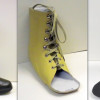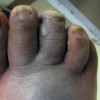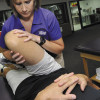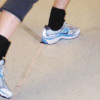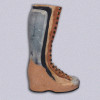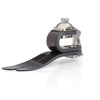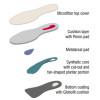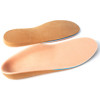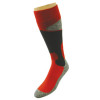 Cover Story
Cover Story
Researchers from New York University have found that wearing high heels increases muscle activation, which can have painful ramifications throughout the kinetic chain. Some individuals, however, seem to adapt to high heels more effectively than others.
By Smita Rao, PT, PhD, and Renata Ripa, MA
Editor Message
A week after this magazine goes to press, I’ll be in Puerto Rico with my in-laws for a beach wedding. I’m sure the scenery will be spectacular. But I also know that once the ceremony is over, I’ll be counting the minutes until I can put my heels back on.
Jordana Bieze Foster, Editor
Departments
The medical literature supports the use of orthotic devices in patients with posterior tibial tendon dysfunction, especially those in the early stages. Demonstrated benefits include improvements in foot and ankle alignment, clinical symptoms, and functional outcomes.
By Holly Olszewski, CPO
Despite the expense associated with advanced wound care technologies, evidence suggests that switching from standard care makes both clinical and economic sense if a diabetic foot ulcer has not experienced a 50 percent reduction in wound area after four weeks.
By Emily Delzell
Some studies support the effectiveness of physical therapy for reducing pain and improving function in patients with hip osteoarthritis, but evidence on the topic is limited and contradictory—suggesting that perhaps PT is most effective in a specific subgroup of patients.
By Alexis A. Wright, PT, PhD, DPT, and Garrett S. Naze, PT, DPT
This two-part series explores the role of rotational forces in athletic injuries and the extent to which bracing can help control those forces and, in turn, prevent those injuries. This second installment examines rotation as a contributor to anterior cruciate ligament injury.
By Cary Groner
Wrong-site surgery can have significant financial and professional consequences, which is why surgeons’ organizations are promoting protocols specifically designed to reduce such errors. A recent survey of foot and ankle surgeons suggests those efforts are paying off.
By Donald E. Fowler III, MD; Karl M. Schweitzer Jr, MD; Olubusola Brimmo, MD; Ryan May, BS; and Selene ...
Research suggests that individuals with chronic ankle instability use different movement strategies to maintain postural control than individuals with healthy ankles. These changes may be related to alterations in movement variability associated with ankle instability.
By Lisa Chinn, MS, ATC, and C. Collin Herb, MEd, ATC
News
In the Moment: Footwear
By Emily Delzell
Recent research from the Netherlands suggests that a custom-made orthopedic shoe designed for temporary use can enhance early mobilization after stroke, improving functional mobility, walking speed, and gait.
By Emily Delzell
Research from the Auckland University of Technology suggests use of poor footwear is a major problem in patients with gout, finding that 42% of individuals studied wore shoes with inadequate cushioning, support, stability, or motion control.
The New Zealand investigators, who ...
Girls who take part in recreational jazz dancing may be wearing dance shoes that adversely affect muscle activation and restrict their ability to attain the optimal pointed, or plantar flexed, position while dancing, according to Australian researchers.
Investigators from the University ...
In the Moment: Sports Medicine
By Jordana Bieze Foster
Achilles injuries in the National Football League appear to be occurring earlier, more frequently, and in younger players than in previous seasons. Whether that apparent trend is related to the labor dispute and lockout that shortened the preseason is a ...
Patients experience significant increases in femoral neck bone density six months after undergoing hip resurfacing, which suggests it is safe for them to return to high-impact sports at that time, according to research from Washington University School of Medicine in ...
Landing on the rearfoot instead of the forefoot during cutting and pivoting tasks can decrease knee loading and theoretically reduce the risk of anterior cruciate ligament injury, according to a study from George Mason and Old Dominion universities.
Researchers assessed knee ...
Two measures of pronation typically associated with later stages of posterior tibial tendon dysfunction are also apparent in its earliest stage, according to University of Calgary research with possible implications for early intervention.
Investigators analyzed static anatomical foot structure, ankle invertor ...
Market Mechanics
Products
AliMed has added to its products a line of bed positioning devices engineered to withstand the compressive weight of bariatric patients and help prevent pressure ulcers. The positioners, made from a closed-cell foam that resists compression better than standard foam, ...
Trulife introduces its first low profile prosthetic foot for community ambulators and high activity amputees – the Seattle LP. Designed of carbon fiber and titanium, this low profile foot is ideally used with long residual limbs. The Seattle LP’s multi-axial ...
Otto Bock HealthCare introduces its 1C60 Triton prosthetic foot. Developed with input from amputees and with an emphasis on full mobility and natural anatomy, the Triton is suitable for everyday use and helps wearers live an active lifestyle. Its flexible ...
KidZerts has released the first wear-moldable arch support insole that shapes itself to match the unique contours of the bottom of a child’s foot. The ethyl vinyl acetate (EVA) moldable sublayer molds slowly to the plantar surface during wear; other ...
Tekscan has released the F-Scan Datalogger for use with its F-Scan System, which captures dynamic in-shoe pressure and force information. The Datalogger collects and stores sensor data in its internal memory for uploading to a computer at a later time, ...
Bauerfeind USA has introduced a heel-focused over-the-counter foot orthosis for the management of plantar fasciitis and heel pain. The Bauerfeind professional heel is an anatomically designed device configured with moderate arch support to provide pain relief and redistribute pressure away ...
Comfort Products Ipocon Gel Sheets are made by Uniprox and constructed of silicone gel. The viscoelastic properties of the material provides partial pressure relief to feet. The sheets are free of Lycra coating and are suited for individuals who need ...
Earthwalk Orthotics introduces the Stratiform multilayered orthotic device, designed for patients with diabetes and other at-risk patients requiring passive support. Construction of the orthosis begins with a high-density EVA (ethylene vinyl acetate) formable. A traditional plaster positive is created from ...
Star Nutrition announces four new products in their Incrediwear line of apparel for the lower extremity, which now includes cycling socks, snowboarding, and skiing socks and shorts. All products are woven with ingredients that release negatively charged anions that help ...
Pro-Tec Athletics’ new Pre-Cut Kinesiology Tape is intended to help relieve muscle tightness, knee pain, iliotibial band syndrome, shin splints, hamstring tears, plantar fasciitis, epicondylitis, wrist pain, and most soft tissue injuries. The tape is designed to promote circulation and ...



